Delaware • New Jersey • Pennsylvania
New York • United States of America
- DRBC Drought Operating Plans
- Dates of DRBC-Declared Basinwide Drought Actions
- DRBC Drought Operation Rule Curves
- The 1960s
- The 1980s
- The 1990s
- The 2000s
- The 2010s
- The 2020s
DRBC takes the lead on the drought operating program regulating river flows and reservoir releases.
DRBC drought operating plans are implemented either Basinwide or for the Lower Basin, based on storage available in several reservoirs.
- Section 2.5 of DRBC's Water Code (pdf) details the Commission's drought operating program.
DRBC Drought Objectives
During drought conditions, the DRBC has several objectives:
- Preserve Reservoir Storage to Protect Water Supply
- Manage the Salt Front to Repel Salinity
- Manage in-stream flows in the mainstem Delaware River
DRBC's drought operations complement the plans of the states, which respond to local water supply conditions, for example, precipitation, groundwater levels, local reservoir storage, soil moisture and streamflow.
DRBC's Basinwide Drought Operations
DRBC Basinwide Drought Plan is based on storage conditions in three New York City (NYC) Delaware River Basin reservoirs, located in the river's headwaters. These reservoirs include:
- Cannonsville Reservoir on the West Branch of the Delaware River
- Pepacton Reservoir on the East Branch of the Delaware River
- Neversink Reservoir on the Neversink River.
To preserve reservoir storage during drought conditions, a storage-based rule curve was developed with trigger points for Drought Watch, Drought Warning and Drought Emergency.
When the combined storage of the NYC reservoirs dips below normal operations levels and stays there for five (5) consecutive days, the drought plan requires phased reductions in:
- Flow objectives for the Delaware River at Montague, N.J. and Trenton, N.J.;
- Out-of-basin diversions to New York City and to New Jersey;
- Conservation release rates from the NYC reservoirs, Beltzville, Blue Marsh, FE Walter and Lake Nockamixon; as well as
- Replacement of consumptive use (evaporative losses) from thermoelectric utilities.
The purpose of the reductions and of the consumptive use replacement is to conserve water in the Basin's reservoirs and to preserve water quality in the Delaware River by controlling the upstream movement of salty water from the Delaware River Estuary.
DRBC's Basinwide Drought Operations are not always triggered by combined storage in the NYC Delaware Reservoirs.
When the DRBC was created in October 1961, Section 10.4 of the Delaware River Basin Compact (pdf) granted the Commission the authority to declare a water supply emergency (after holding a public hearing) based on "a drought or other condition which may cause an actual and immediate shortage of available water." Additionally, pursuant to Section 3.3(a) of the Compact, the Commission may declare a state of emergency resulting from a drought by unanimous consent of all members.
These provisions provide the DRBC with the authority to manage an additional 69 billion gallons of water from private, state and federally owned reservoirs during a drought emergency, helping reduce uncertainty in the management of water supply during periods of drought.
→ DRBC Water Supply Emergency Declarations
- DRBC declared a water supply emergency during the Drought of Record in the 1960s. It was not until the following decade that the DRBC began to define drought operations using rule curves that represented combined storage in Neversink, Pepacton and Cannonsville reservoirs.
- The DRBC declared a water supply emergency in 2016, exercising its authority pursuant to section 10.4 of the Compact to address overall dry conditions throughout the Basin, placing the entire Delaware River Basin in drought watch.
- The DRBC declared a water supply emergency in December 2024, exercising its authority pursuant to section 10.4 of the Compact to address persistently dry conditions throughout the Basin, which ended in June 2025.
DRBC's Lower Basin Drought Operations
There are times when hydrologic conditions and reservoir storage are "normal" in the upper basin, but the Lower Basin may be experiencing drought conditions. When this occurs, the Upper Basin is operated normally while the Lower Basin Drought Operating Plan is triggered.
DRBC Lower Basin Drought Plans - for the portion of the Basin downstream of Montague, N.J. - are triggered by storage elevations in Blue Marsh and Beltzville reservoirs. Owned by the U.S. Army Corps of Engineers:
- Blue Marsh Reservoir is located on the Tulpehocken Creek, a tributary of the Schuylkill River
- Beltzville Reservoir is located on the Pohopoco Creek, a tributary of the Lehigh River
The DRBC's Lower Basin Drought Management Plan focuses on controlling the upstream migration of salty water (referred to as the "salt front") from the Atlantic Ocean through the Delaware Bay into the tidal river during dry conditions. If there is not enough freshwater flowing downstream into the estuary, the salt front can creep upstream, threatening the drinking water intakes along the Delaware River in Philadelphia and Camden.
The DRBC can direct releases from either Blue Marsh or Beltzville reservoir to help repel, or flush back, the salt-laced water. DRBC owns water supply storage in these reservoirs for this purpose, which is financed by surface water users under a water charging program implemented by the DRBC.
When both reservoirs fall below their respective drought warning and drought levels, the Trenton flow objective and diversions to N.J.'s Delaware and Raritan Canal are reduced. Lower Basin operations are controlled by both Basinwide or Lower Basin storage triggers, with the most limiting restrictions controlling; typically, Basinwide drought operations prevail over Lower Basin drought operations.
Lower Basin drought operations were approved a few years after the Basinwide drought criteria were developed. Recommendation 4 of the Good Faith Agreements (pdf) declared criteria for defining Lower Basin drought warning and drought be prepared. In June 1983, the Commission directed its Flow Management Technical Advisory Committee to develop alternative operating plans using criteria from Recommendation 4. The operating plans were approved by resolution in September 1988 (pdf). To date, the only Lower Basin drought declared by DRBC occurred in 2010.
Consumptive Use Replacement
To help repel salinity in the Delaware Estuary, power-generating facilities are required to replace consumptive use.
Consumptive use is water used that is not returned to the system. Power generation causes large evaporative losses of water that are considered consumptive.
Merrill Creek Reservoir, a pumped storage facility located near Phillipsburg in Warren County, N.J., is owned by a conglomerate of power companies in the Basin. It was created to store water, which can be released to replace evaporative water losses caused by power generation when the Basin is under DRBC-declared drought operations. Releases are made during both Basinwide and Lower Basin drought warnings and droughts whenever the flow at Trenton drops below 3,000 cfs for at least five consecutive days, allowing power companies to continue to supply much-needed power without adversely affecting streamflows.
Most of the electric generating or cogenerating facilities in the Basin operate under dockets that contain a requirement for the replacement of water that is used consumptively. In 2018, the DRBC approved a uniform consumptive use replacement policy for electric generating or cogenerating facilities during critical hydrologic conditions.
Additionally, the DRBC developed guidance for the development of Drought Management and Contingency Plans (DMCPs), required for industrial or commercial surface or ground water withdrawals greater than one (1) million gallons per day in the event of a Commission-declared drought or other water shortage.
An Overview of Drought in the Delaware River Basin (February 2019; pdf)
|
|
Enter Drought |
Enter Drought Warning (2) |
End Drought Watch/Warning |
Enter Drought (3) |
Declare Drought Emergency |
End Drought Emergency |
|
1960s |
|
|
|
|
7/7/65 |
3/15/67 |
|
1980s |
10/17/80 |
|
|
|
1/15/81 |
4/27/82 |
|
11/13/82 |
|
3/27/83 |
|
|
||
|
11/09/83 |
-- |
12/20/83 |
|
|
||
|
1/23/85 |
2/7/85 |
|
|
5/13/85 |
12/18/85 |
|
|
1/16/89 |
2/5/89 |
5/12/89 |
|
3/21/89 Conditional |
|
|
|
1990s |
9/13/91 |
11/7/91 |
6/17/92 |
|
|
|
|
9/21/93 |
-- |
12/6/93 |
|
|
||
|
9/15/95 |
10/13/95 |
11/12/95 |
|
|
||
|
10/27/97 |
-- |
1/13/98 |
|
|
||
|
|
1/5/99 Conditional |
|
||||
|
|
|
|
|
|||
|
2000s |
10/29/01 |
|
11/25/02 |
|||
|
2010s |
-- |
|
|
|
Notes:
1. The "Enter Drought Watch" column represents the date combined storage in the NYC reservoirs triggered Basinwide drought watch operations. Combined storage must remain below the normal line on the operation curves for five consecutive days before drought watch operations are triggered. Prior to May 1999, this level of drought was labeled "Drought Warning 1 (DW1)" on the operation curves (refer to Figures A and B below).
2. The "Enter Drought Warning" column represents the date combined storage in the NYC reservoirs declined below the drought warning line and triggered Basinwide drought warning operations. There is no waiting period to enter this level of drought. Prior to May 1999, this level of drought was labeled "Drought Warning 2 (DW2)" on the operation curves. A "--" in the Enter Drought Warning column means the Basin returned to normal operations before drought warning operations were triggered.
3. The "Enter Drought" column represents the date the combined storage in the NYC reservoirs triggered Basinwide drought operations. Combined storage must remain below the drought line for five consecutive days before drought operations are triggered.
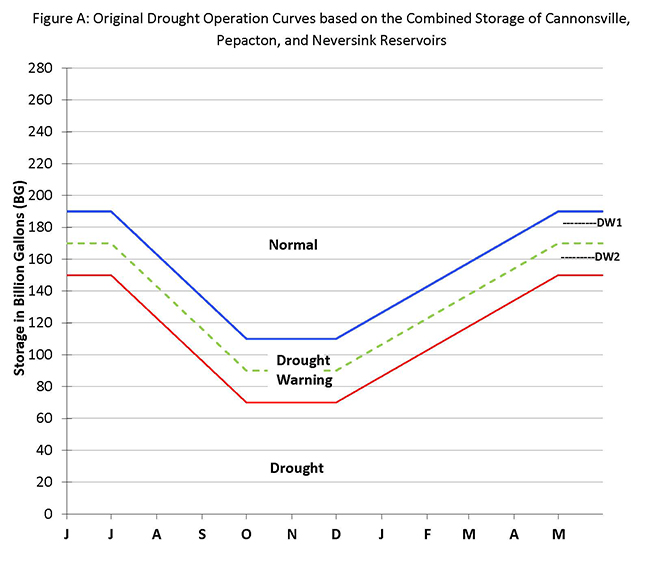
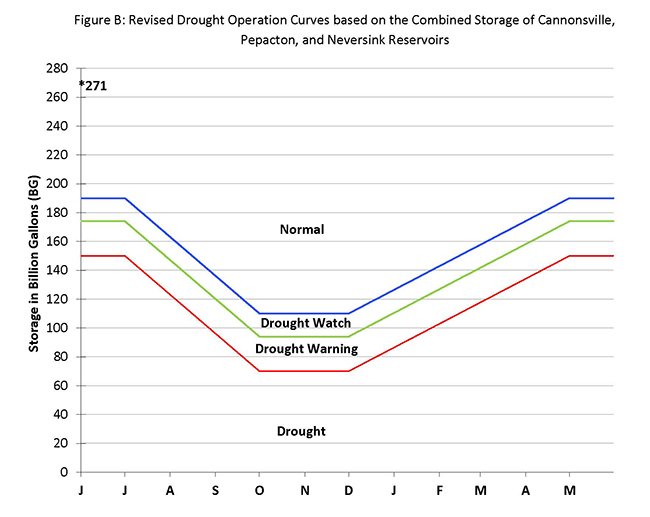
The northeastern section of the country experienced the "drought of record" beginning in 1962. Precipitation deficits increased with each passing year. By July 1965, the U.S. Weather Bureau's Palmer Index indicated that extreme drought conditions existed over 100,000 square miles, extending from the Mid-Atlantic states to New England.
Saltwater intrusion into the estuary threatened the water supplies of Philadelphia and Camden. The maximum recorded upstream location of the salt front occurred in November 1964, when the front reached river mile 102. This location is eight miles downstream of Philadelphia's drinking water intake on the Delaware River and within Camden's groundwater recharge area.
DRBC declared its first-ever drought emergency in July 1965. That month, the Commission adopted a resolution to declare a water supply emergency and another to modify the 1954 Supreme Court Decree, with unanimous consent of the Decree Parties, to reduce NYC's out-of-Basin diversion, reduce the flow target at Montague, N.J. and limit releases from the NYC reservoirs to conserve storage.
DRBC also issued conservation orders to other reservoir systems in the Basin to store water in order to be released to augment freshwater flows into the river and estuary to help limit the advance of the salt front.
Later in 1965, flow objectives at Montague and Trenton, N.J. were lowered to further decrease demand on reservoir storage.
Drought continued in the Delaware River Basin into 1966. Due to the uncertain hydrologic conditions, DRBC extended the drought emergency several times during the year. Precipitation amounts, streamflow and groundwater levels all began to improve by the fall of 1966. Storage in the NYC reservoirs increased to normal after a wet fall and winter of 1966-67. Groundwater was also recharged. Confident that the six-year drought had come to an end, DRBC adopted a resolution in March 1967, terminating its 20-month long water supply emergency.
The 1960s drought was the subject of a study by the Inter-University Case Program. The Delaware River Drought Emergency (pdf) by Richard A. Hogarty was published in 1970.
The Basin entered drought watch operations multiple times during the 1980s. Conditions warranted drought emergency actions for three of these drought events.
1980 - 1982
Midway through 1980, growing precipitation deficits resulted in below-normal groundwater levels, reservoir storage and streamflow. On October 17, combined storage levels in the NYC reservoirs were at 40 percent capacity and in the "drought warning condition" as defined by the NYC reservoir operation curves in Resolution No. 80-20 (pdf). By January 1981, combined storage in the NYC reservoirs declined to 31 percent of capacity and precipitation totals since May 1, 1980, were more than 30 percent below normal. DRBC met for a special session on January 15 and formally declared a drought emergency (Resolution No. 81-01; pdf). Combined storage in the NYC Delaware reservoirs declined to 25-percent capacity before above-normal precipitation during February 1981 added more than 100 billion gallons to the reservoirs. Storage increased to above drought warning for the first time in several months and remained above the warning level for the rest of 1981. The highest location of the salt front during 1981 was river mile 92. The three NYC reservoirs refilled in April 1982, prompting DRBC to unanimously vote to end the drought emergency on April 27, 1982 (Resolution No. 82-04; pdf).
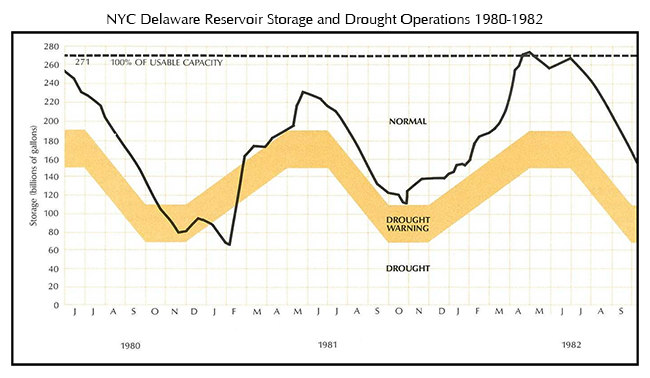
1985
Dry conditions caused storage in the NYC reservoirs to decrease to the drought watch range in January 1985. Normally the reservoirs should have been nearly full on May 1, but in 1985 the combined storage was only 62 percent of usable storage. A drought emergency was declared on May 13, 1985, by Resolution No. 85-13 (pdf). The salt front reached river mile 89. By the early fall, conditions improved significantly, especially with the arrival of Hurricane Gloria on September 27, which produced as much as nine inches of rain in the Basin. The streamflow at Trenton went from a drought-level of 2,800 cfs to nearly 89,000 cfs (less than four feet below flood stage). Freshwater inflows into the Delaware River moved the salt front more than 20 miles downstream from its furthest upstream location at river mile 89 (near the Philadelphia International Airport). DRBC officially lifted the drought emergency on December 18, 1985, by the adoption of Resolution No. 85-50 (pdf).
1989
Long-term precipitation deficits and a heatwave during the summer of 1988 placed heavy demands on NYC's water supply system. Storage declined to the drought watch (DW1) range in January 1989. On March 21, 1989, DRBC declared a conditional drought emergency (Resolution No. 89-07; pdf), which would have gone into effect had the NYC reservoirs dropped below the drought curve and remained there for five consecutive days. However, the upper Basin received enough rain over the next few months to replenish the reservoirs and raise the NYC combined reservoir storage back into the normal range by early May. The improved conditions meant a drought emergency was not necessary and normal operations were reinstated on May 12, 1989.
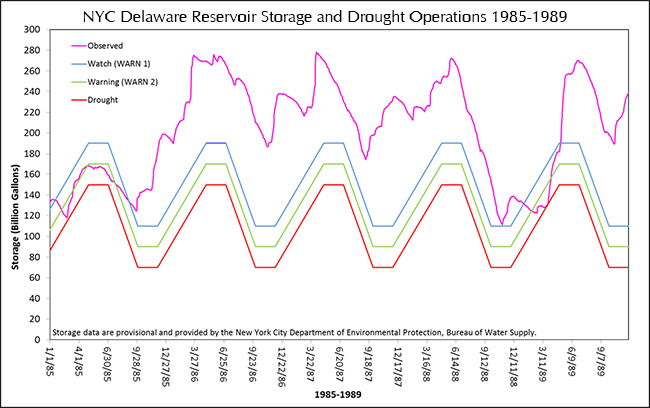
The Basin entered drought operations multiple times during the 1990s. Two of these droughts were severe enough for DRBC to implement the drought emergency actions described below.
November 1998- February 1999
Annual precipitation deficits approached 12 inches in parts of the Basin during the second half of 1998. On 11/21/98, special action was taken before the combined storage in the three NYC Delaware reservoirs officially entered drought watch operations. This action included reducing flow objectives at Montague, N.J. and Trenton, N.J. and reducing the NYC and N.J. diversions. Drought watch operations were not officially entered until 12/14/98 and drought warning operations were entered on 12/23/98. The DRBC declared a conditional drought emergency on 1/5/99 (Resolution No. 99-01; pdf). The emergency would have gone into effect had the storage in the NYC reservoirs declined to the drought zone and remained there for five consecutive days. Instead, hydrologic conditions improved in January when consecutive storms provided enough water to increase storage in the NYC reservoirs. The drought warning was terminated in February.
July – September 1999
Drought conditions returned to the DRB in June 1999. By mid-August, below-normal flow on the Delaware River caused the salt front to advance upstream to near the Philadelphia International Airport (river mile 89). Although storage in the NYC reservoirs did not trigger basinwide drought operations, DRBC determined that pre-emptive drought management actions were necessary to conserve water. On July 21, 1999, the flow objective at Trenton was reduced from 3,000 cfs to 2,700 cfs in an effort to conserve storage in Beltzville and Blue Marsh reservoirs. On August 18, 1999, the DRBC adopted additional emergency drought actions such as storing water in F.E. Walter Reservoir in the upper reaches of the Lehigh River and requesting releases from Nockamixon Reservoir, Lake Wallenpaupack and the Mongaup System (Resolution 99-18; pdf). The drought actions were only needed until September 16 when the Basin received six to ten inches of rain over an 18-hour period from Hurricane Floyd (pdf). After Floyd, water supply storage, groundwater and streamflow improved and the emergency drought actions were terminated on September 30, 1999, by Resolution 99-22 (pdf).
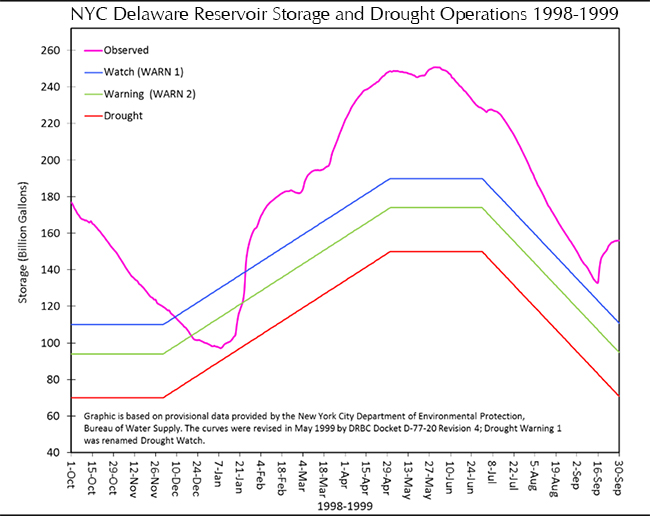
The Basin entered Basinwide drought operations only once during this decade, but drought conditions were so severe that a drought emergency declaration was warranted.
December 2001- November 2002
By the end of October 2001, the upper Basin's annual precipitation deficit was nearly eight inches. By late November, NYC Delaware reservoir storage descended below the drought operations curve and the salt front had moved upstream to river mile 86. On December 15, 2001, the combined storage in the reservoir system declined to a record combined-storage low of 63.3 billion gallons for the three reservoirs, which is less than 25% of usable capacity. DRBC declared a drought emergency by Resolution 2001-32 (pdf) on December 18, 2001.
Below-normal precipitation persisted into 2002. A wet weather pattern returned in the spring, improving streamflows, groundwater levels, and reservoir storage. But, dry weather returned in the summer and early fall, and below normal flows on the mainstem Delaware caused the salt front to advance upstream to river mile 89 near the Philadelphia International Airport. By late September, wet weather again returned, and drought indicators improved. On November 25, 2002, DRBC adopted Resolution 2002-31 (pdf) ending the drought emergency. During this drought, approximately 500 million gallons of water were conserved per day through DRBC's Basinwide Drought Operating Plan. Details about the drought of 2001-2002 are provided in Chronology of Drought in the Delaware River Basin (pdf).
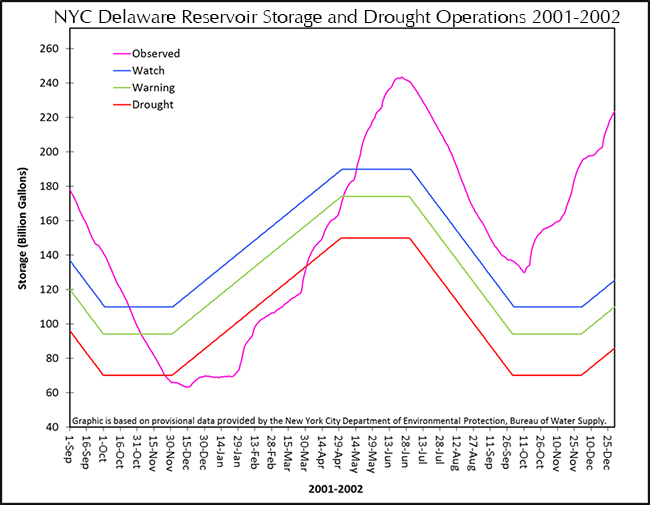
Lower Basin Drought Operations: September - October 2010
The only Lower Basin drought declared by DRBC occurred in 2010. On September 24, 2010, DRBC issued a Lower Basin Drought Warning. Persistently dry weather conditions over the summer necessitated directed releases from the Beltzville and Blue Marsh reservoirs in order to meet the flow objective at Trenton, N.J. The amount of water in those reservoirs was thereby reduced to levels that automatically triggered the lower basin drought warning declaration. Heavy rainfall during the last week of September increased storage in both reservoirs to above the drought warning elevations. The drought warning was lifted on October 31, 2010 after elevations in both reservoirs had been above the trigger per the Lower Basin Drought Operating Plan.
Basinwide Drought Operations: November 2016 - January 2017
Drought returned to the Basin late in 2016. In response to declining reservoir storage and increasing precipitation deficits, DRBC held a drought hearing on November 9, 2016 to accept public input about the drought issues impacting the Basin.
- View presentation given at November 9, 2016 public hearing (pdf)
On November 23, as combined storage in the NYC Delaware reservoirs declined to the drought watch range, DRBC held a special meeting and unanimously approved Resolution 2016-07 (pdf) for coordinated operation of regional reservoirs, out-of-Basin diversions, and Delaware River flow objectives in response to the persistent dry conditions. The resolution deemed the entire Basin under a drought watch.
- FAQs: DRBC Drought Management (pdf)
- Press Release: DRBC Approves Drought Management Special Permit - Basin Placed in "Drought Watch" Stage Effective Immediately (issued 11/23/16)
- Presentation on DRBC Drought Management (given at 10/27/16 WMAC Mtg.; pdf)
The drought was short-lived, but before it ended the salt front had reached as far upstream as river mile 90 in late November.
At the December 14, 2016 DRBC business meeting, Resolution 2016-8 (pdf) was approved, which temporarily placed water stored in Lake Wallenpaupack and the Mongaup Reservoir System under operations designed to preserve and protect water supplies in the Basin during a period of persistent dry conditions.
The month of December brought increased precipitation, improving streamflow, groundwater levels and reservoir storage throughout the Basin. The Commission lifted the Basinwide Drought Watch on January 18, 2017.
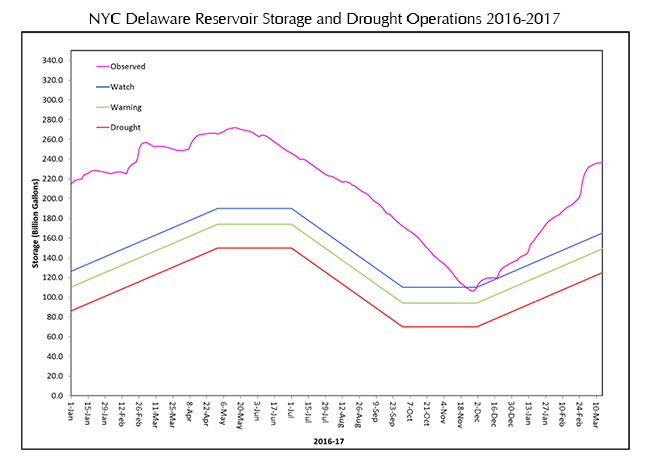
In December 2024, after several months of persistently dry conditions, the DRBC passed resolutions declaring a "water supply emergency." The water supply emergency was continued in March 2025 and ended in June 2025.
DRBC Water Supply Emergency Archives
- December 2024: Approves Drought Management Operations
- View News Release (issued December 5, 2024)
- Resolution 2024-07 (pdf; NOTE: Drought Management Special Permit No. 2024-01 is included in this Resolution as Para. 3 in BE IT RESOLVED section)
- Resolution 2024-08 (pdf; NOTE: certain terms of this Resolution operate as the second special permit)
- FAQ: DRBC Drought Management (pdf)
- Hydrologic Conditions Update (pdf; presentation given Dec. 5, 2024)
- November 19, 2024, Special Public Hearing on the persistent dry conditions
- View News Release (issued December 5, 2024)
- March 2025: Extends Special Permit
- Resolution 2025-1 (pdf; approved March 12, 2025; extends drought management special permit)
- Resolution 2025-1 (pdf; approved March 12, 2025; extends drought management special permit)
- June 2025: Ends Water Supply Emergency
- Resolution 2025-5 (pdf; approved June 11, 2025; ends water supply emergency & allows special permits to expire)
Copyright © Delaware River Basin Commission,
P.O. Box 7360, West Trenton, NJ 08628-0360
Phone (609)883-9500; Fax (609)883-9522
Thanks to NJ for hosting the DRBC website